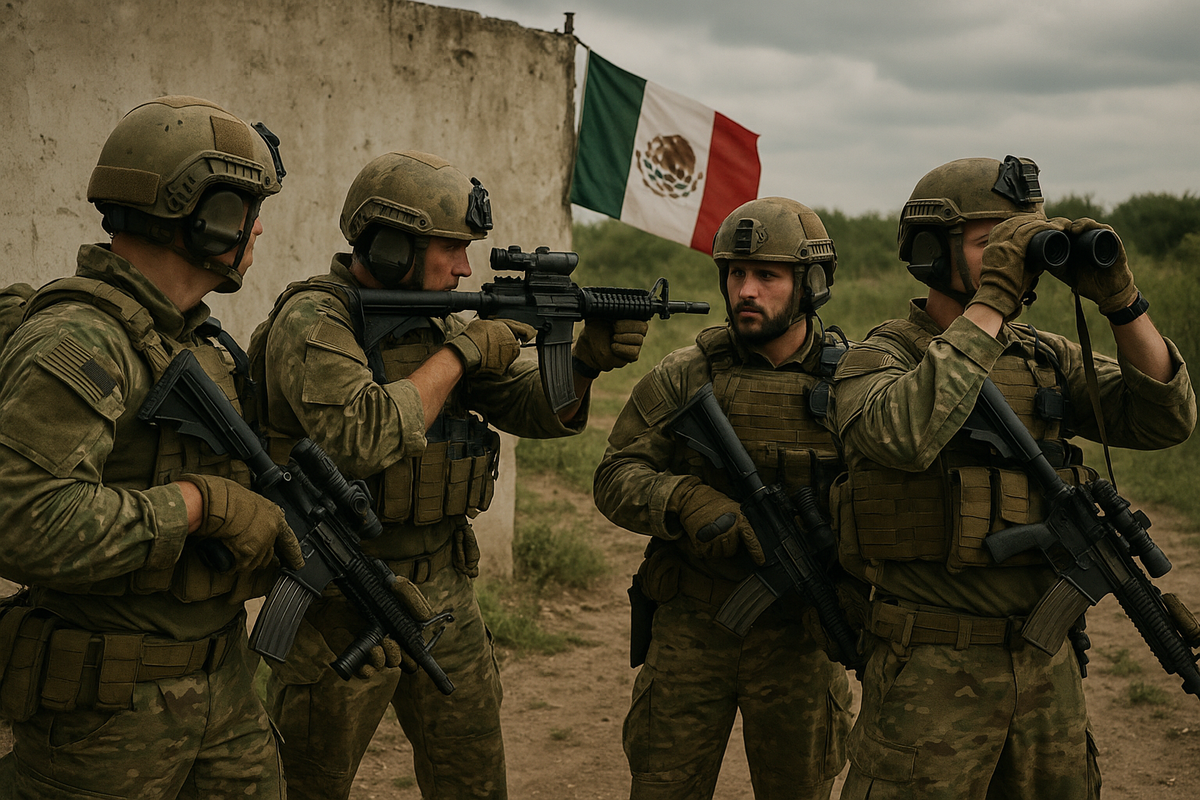US military to attack Cartels
History shows that militarized solutions rarely succeed against deeply embedded criminal networks. Whether this strategy becomes reality—or remains a pressure tactic—will shape North America’s security and diplomatic landscape for years to come.

Military Preparing Attacks on Mexican Cartels: A Geopolitical Flashpoint
By Rafael Benavente
Introduction
In August 2025, journalist Ken Klippenstein published a bombshell report: the Trump administration had quietly ordered U.S. Northern Command (NORTHCOM) to prepare lethal strikes against Mexican drug cartels inside Mexico. According to military sources, the classified directive called for "target packages" and operational readiness by mid‑September 2025.
If carried out, this would mark one of the most dramatic escalations in U.S. policy toward its southern neighbor in decades. It would blur the line between the war on drugs and counterterrorism, raising profound legal, diplomatic, and ethical questions.
This blog explores the issue through multiple media reports, contextual history, and potential consequences for U.S.–Mexico relations.
(Suggested picture: Header image — composite of U.S. military vehicles, Mexican border landscapes, and a map overlay.)
1. The Revelations
Klippenstein’s reporting detailed a top-secret order issued in late spring 2025. For the first time, NORTHCOM—normally focused on homeland defense—was tasked with creating operational strike plans against specific Mexican cartels, including the Sinaloa Cartel and Jalisco New Generation Cartel (CJNG). These operations were not limited to intelligence support; they envisioned direct action by U.S. special forces inside Mexican territory.
Historically, such operations were conducted covertly under the CIA or Joint Special Operations Command (JSOC). NORTHCOM’s involvement suggests a broader military integration and a shift toward normalization of cross-border lethal action.
(Suggested picture: Infographic — timeline from “Late Spring 2025 directive” → “August 2025 media leak” → “September 2025 operational readiness.”)
2. Media Coverage & Perspectives
Reuters & AP
Reuters confirmed preparations for U.S. Navy deployments to the Caribbean, including guided-missile destroyers positioned near Venezuela. While officially framed as counter-narcotics missions, sources described them as part of the broader anti-cartel escalation. AP noted that three destroyers—the USS Gravely, USS Jason Dunham, and USS Sampson—were deployed for deterrence and operational flexibility.
The Guardian
The Guardian highlighted the strong backlash from Mexico. President Claudia Sheinbaum rejected any U.S. military action on Mexican soil, labeling it a threat to sovereignty. Mexico’s Foreign Ministry stated unequivocally: “There will be no U.S. boots on Mexican territory.”
Washington Post
The Washington Post emphasized the legal front, reporting on simultaneous Department of Justice indictments and sanctions against the so-called United Cartels. The U.S. placed multimillion-dollar bounties on leaders like Juan José “El Abuelo” Farias, while freezing assets under terrorism-related laws.
Financial Times
The FT provided structural context, describing how Mexican cartels have evolved into transnational criminal enterprises, deploying drones, encrypted communications, and semi-submersibles. This shift has fueled Washington’s argument that cartels are no longer just drug gangs, but terrorist organizations with global reach.
(Suggested picture: Side-by-side collage — U.S. Navy destroyer, Mexican presidential palace, DOJ press conference.)
3. Mexico’s Firm Response
Mexico has been here before. From the 2007 Mérida Initiative to covert surveillance programs like Operation Lowrider, cooperation with the U.S. has often blurred lines. But outright U.S. military incursions remain politically toxic.
Sheinbaum, facing rising domestic violence tied to cartels, cannot afford to appear weak. Analysts argue that U.S. unilateral action would undermine Mexican legitimacy, spark nationalist backlash, and potentially push parts of Mexico’s military establishment to distance themselves from Washington.
(Suggested picture: Mexican military parade — soldiers with flags, emphasizing sovereignty.)
4. Historical Context
The Mérida Initiative (2007–2021)
- A $3 billion U.S. program supplying Mexico and Central America with training, helicopters, and surveillance tech.
- Explicitly barred U.S. military combat on Mexican soil.
Operation Lowrider
- A little-known surveillance campaign begun in 2011, using U.S. contractors flying manned aircraft over Mexico.
- Generated controversy for bypassing Mexican oversight.
Designating Cartels as Terrorist Organizations
- In February 2025, Trump’s administration formally designated several Mexican cartels as Foreign Terrorist Organizations (FTOs).
- This opened the legal door for military strikes abroad, under the same authorities used for al-Qaeda and ISIS.
(Suggested picture: Chart — "From Mérida Initiative → FTO Designation → Military Strike Planning.")
5. Legal and Ethical Questions
- International Law: The UN Charter prohibits cross-border use of force without host nation consent or UN Security Council authorization. U.S. unilateral strikes could be interpreted as aggression.
- Precedent: If cartels are treated like ISIS, would the same logic apply to other criminal groups worldwide? Could this justify foreign interventions in Latin America, Africa, or Asia?
- Collateral Damage: Cartels often operate in urban environments. Military strikes could cause civilian casualties, worsening anti-American sentiment.
(Suggested picture: Photo of a UN meeting, symbolizing international law constraints.)
6. Strategic Implications
Diplomatic Fallout
- U.S.–Mexico trade under the USMCA is valued at over $850 billion annually. A breakdown in relations could disrupt supply chains.
- Mexico could limit intelligence-sharing, hampering U.S. counter-narcotics efforts.
Security Risks
- Cartels may retaliate against U.S. citizens in Mexico or along the border.
- Violence could escalate within Mexico as cartels rally nationalist narratives against "foreign occupation."
Domestic Politics
- Trump’s move appeals to voters demanding a tough stance on fentanyl and border security.
- Democrats and civil liberties groups warn it risks a new “forever war” in the Western Hemisphere.
(Suggested picture: Split screen — U.S. border wall image vs. fentanyl seizure photo.)
7. Broader Regional Dynamics
Cartels are no longer confined to Mexico. They operate in Ecuador, Colombia, Peru, and Venezuela. U.S. deployments near Venezuela indicate Washington sees the issue as hemispheric.
China and Russia also loom in the background. Both have expanded influence in Latin America, providing infrastructure financing and military equipment. U.S. military actions could be framed as an effort to counter these geopolitical rivals under the banner of anti-cartel operations.
(Suggested picture: Map of Latin America with arrows showing cartel routes and U.S. naval deployments.)
8. The Role of Technology
Cartels have innovated rapidly:
- Drones: Used for reconnaissance and even grenade drops.
- Semi-submersibles: Custom-built vessels capable of carrying tons of cocaine across oceans.
- Cyber networks: Encrypted apps, money laundering via cryptocurrencies.
The U.S. military argues these tools make cartels comparable to insurgent groups.
(Suggested picture: Drone image + semi-submarine photo collage.)
9. Alternatives to Militarization
Critics argue military strikes are not the solution. Alternatives include:
- Strengthening Mexican institutions: Funding police reform and judicial independence.
- Demand-side reduction: Tackling U.S. consumption of fentanyl and meth.
- Binational task forces: Joint U.S.–Mexico special units under shared command.
- Economic development: Targeting regions most vulnerable to cartel recruitment.
(Suggested picture: Community development project photo — symbolizing non-military solutions.)
10. Conclusion
The revelation that the U.S. military is preparing attacks inside Mexico represents a watershed moment. It reflects both desperation at the fentanyl epidemic and frustration with traditional law enforcement approaches. But it also carries grave risks: to international law, to U.S.–Mexico relations, and to civilian lives.
History shows that militarized solutions rarely succeed against deeply embedded criminal networks. Whether this strategy becomes reality—or remains a pressure tactic—will shape North America’s security and diplomatic landscape for years to come.
By Rafael Benavente
